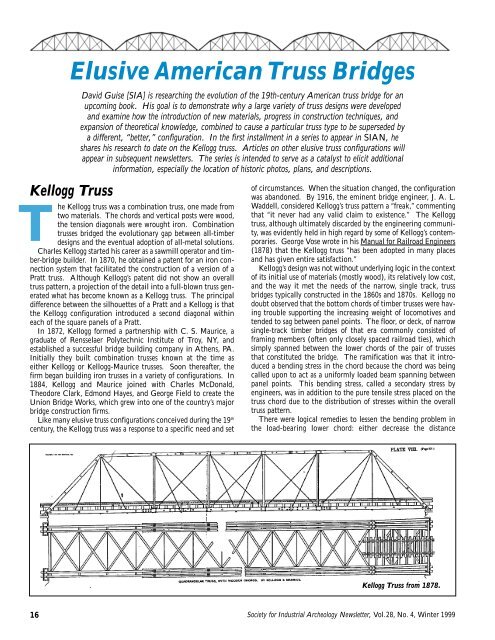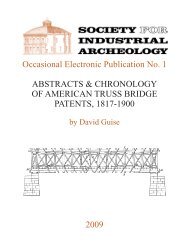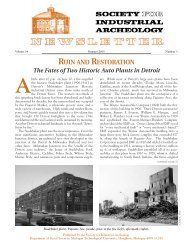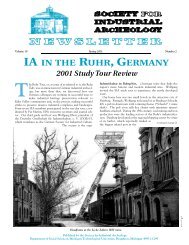birmingham, “pittsburgh of the south,” - Society for Industrial ...
birmingham, “pittsburgh of the south,” - Society for Industrial ...
birmingham, “pittsburgh of the south,” - Society for Industrial ...
You also want an ePaper? Increase the reach of your titles
YUMPU automatically turns print PDFs into web optimized ePapers that Google loves.
Elusive American Truss Bridges<br />
Kellogg Truss<br />
David Guise [SIA] is researching <strong>the</strong> evolution <strong>of</strong> <strong>the</strong> 19th-century American truss bridge <strong>for</strong> an<br />
upcoming book. His goal is to demonstrate why a large variety <strong>of</strong> truss designs were developed<br />
and examine how <strong>the</strong> introduction <strong>of</strong> new materials, progress in construction techniques, and<br />
expansion <strong>of</strong> <strong>the</strong>oretical knowledge, combined to cause a particular truss type to be superseded by<br />
a different, “better,<strong>”</strong> configuration. In <strong>the</strong> first installment in a series to appear in SIAN, he<br />
shares his research to date on <strong>the</strong> Kellogg truss. Articles on o<strong>the</strong>r elusive truss configurations will<br />
appear in subsequent newsletters. The series is intended to serve as a catalyst to elicit additional<br />
in<strong>for</strong>mation, especially <strong>the</strong> location <strong>of</strong> historic photos, plans, and descriptions.<br />
he Kellogg truss was a combination truss, one made from<br />
two materials. The chords and vertical posts were wood,<br />
<strong>the</strong> tension diagonals were wrought iron. Combination<br />
trusses bridged <strong>the</strong> evolutionary gap between all-timber<br />
designs and <strong>the</strong> eventual adoption <strong>of</strong> all-metal solutions.<br />
Charles Kellogg started his career as a sawmill operator and timber-bridge<br />
builder. In 1870, he obtained a patent <strong>for</strong> an iron connection<br />
system that facilitated <strong>the</strong> construction <strong>of</strong> a version <strong>of</strong> a<br />
Pratt truss. Although Kellogg’s patent did not show an overall<br />
truss pattern, a projection <strong>of</strong> <strong>the</strong> detail into a full-blown truss generated<br />
what has become known as a Kellogg truss. The principal<br />
difference between <strong>the</strong> silhouettes <strong>of</strong> a Pratt and a Kellogg is that<br />
<strong>the</strong> Kellogg configuration introduced a second diagonal within<br />
each <strong>of</strong> <strong>the</strong> square panels <strong>of</strong> a Pratt.<br />
In 1872, Kellogg <strong>for</strong>med a partnership with C. S. Maurice, a<br />
graduate <strong>of</strong> Rensselaer Polytechnic Institute <strong>of</strong> Troy, NY, and<br />
established a successful bridge building company in A<strong>the</strong>ns, PA.<br />
Initially <strong>the</strong>y built combination trusses known at <strong>the</strong> time as<br />
ei<strong>the</strong>r Kellogg or Kellogg-Maurice trusses. Soon <strong>the</strong>reafter, <strong>the</strong><br />
firm began building iron trusses in a variety <strong>of</strong> configurations. In<br />
1884, Kellogg and Maurice joined with Charles McDonald,<br />
Theodore Clark, Edmond Hayes, and George Field to create <strong>the</strong><br />
Union Bridge Works, which grew into one <strong>of</strong> <strong>the</strong> country’s major<br />
bridge construction firms.<br />
Like many elusive truss configurations conceived during <strong>the</strong> 19th T<br />
century, <strong>the</strong> Kellogg truss was a response to a specific need and set<br />
<strong>of</strong> circumstances. When <strong>the</strong> situation changed, <strong>the</strong> configuration<br />
was abandoned. By 1916, <strong>the</strong> eminent bridge engineer, J. A. L.<br />
Waddell, considered Kellogg’s truss pattern a “freak,<strong>”</strong> commenting<br />
that “it never had any valid claim to existence.<strong>”</strong> The Kellogg<br />
truss, although ultimately discarded by <strong>the</strong> engineering community,<br />
was evidently held in high regard by some <strong>of</strong> Kellogg’s contemporaries.<br />
George Vose wrote in his Manual <strong>for</strong> Railroad Engineers<br />
(1878) that <strong>the</strong> Kellogg truss “has been adopted in many places<br />
and has given entire satisfaction.<strong>”</strong><br />
Kellogg’s design was not without underlying logic in <strong>the</strong> context<br />
<strong>of</strong> its initial use <strong>of</strong> materials (mostly wood), its relatively low cost,<br />
and <strong>the</strong> way it met <strong>the</strong> needs <strong>of</strong> <strong>the</strong> narrow, single track, truss<br />
bridges typically constructed in <strong>the</strong> 1860s and 1870s. Kellogg no<br />
doubt observed that <strong>the</strong> bottom chords <strong>of</strong> timber trusses were having<br />
trouble supporting <strong>the</strong> increasing weight <strong>of</strong> locomotives and<br />
tended to sag between panel points. The floor, or deck, <strong>of</strong> narrow<br />
single-track timber bridges <strong>of</strong> that era commonly consisted <strong>of</strong><br />
framing members (<strong>of</strong>ten only closely spaced railroad ties), which<br />
simply spanned between <strong>the</strong> lower chords <strong>of</strong> <strong>the</strong> pair <strong>of</strong> trusses<br />
that constituted <strong>the</strong> bridge. The ramification was that it introduced<br />
a bending stress in <strong>the</strong> chord because <strong>the</strong> chord was being<br />
called upon to act as a uni<strong>for</strong>mly loaded beam spanning between<br />
panel points. This bending stress, called a secondary stress by<br />
engineers, was in addition to <strong>the</strong> pure tensile stress placed on <strong>the</strong><br />
truss chord due to <strong>the</strong> distribution <strong>of</strong> stresses within <strong>the</strong> overall<br />
truss pattern.<br />
There were logical remedies to lessen <strong>the</strong> bending problem in<br />
<strong>the</strong> load-bearing lower chord: ei<strong>the</strong>r decrease <strong>the</strong> distance<br />
Kellogg Truss from 1878.<br />
16 <strong>Society</strong> <strong>for</strong> <strong>Industrial</strong> Archeology Newsletter, Vol.28, No. 4, Winter 1999






